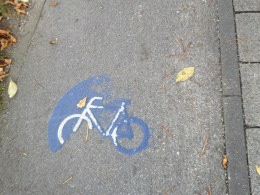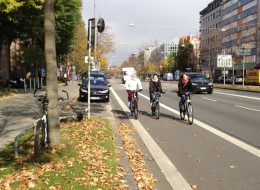
(Photos © Denver Igarta)
— This guest article was written by Denver Igarta. Denver is a transportation planner with the City of Portland who’s on a study trip in Europe funded in part by the German Marshall Fund.

(Photo © J. Maus)
In 2009, Munich’s City Council set the target of increasing the share of bicycle traffic from 14% to 17% of all trips by 2015. They embarked on a creative marketing campaign called Bicycle Capital Munich to help make it a reality.
Today, the city faces an awkward dilemma. The latest numbers show that they have reached the 17% goal four years ahead of schedule. Now, they must decide whether to continue promoting cycling, set a higher target, or simply be content with their success.
“The existing infrastructure — commonly 4 to 5 foot cycle tracks built two to three decades ago — is no longer adequate to serve the growing demand, and conflicts with people on foot are on the rise.”
And beyond the marketing conundrum, the cycling boom has been accompanied by rising concerns about inadequate facilities. Many who work for the city will admit the swelling number of people on bikes has caught them a bit off guard. And, the existing infrastructure — commonly 4 to 5 foot cycle tracks built two to three decades ago — is no longer adequate to serve the growing demand, and conflicts with people on foot are on the rise.
Coming from Portland, a city that has experienced its own cycling boom — from 2% to 8% commute share in 12 years — the issues of bicycle volumes exceeding capacity on the most popular routes is all too familiar.
Interestingly, the bicycling community in Munich is fighting for the right to use busy streets alongside motorists. The hottest issue among bicycle advocates in Munich appears to be the fight to eliminate rules obligating people on bikes to use narrow cycle tracks.

The sign sporting the blue circle with bike symbol means riders must use the designated cycle track, which in the case of a narrow cycle track is increasingly viewed as more of a restriction rather than being granted permission.
The most fascinating aspect of Munich’s dilemma, for me, is the fact that the bicycle community is demanding wide bike lanes rather than cycle tracks.

On two popular bicycle routes, i.e., Seidlstrasse and Rosenheimerstrasse, the cycle tracks have been decommissioned and replaced with wide bike lanes (2 meters) on the roadway.
On Seidlstrasse, the only signs of the old roadway configuration are faint lines where the old travel lanes were once marked. The asphalt that once delineated the abandoned cycle track has been removed and replaced with the standard pavers used for Munich sidewalks. The width of the new bike lanes seems to offer ample space for riding side-by-side comfortably despite the steady flow of traffic. There are still some who prefer to have a separated cycle track, I learned from local experts. But most recognize widening the cycle track would require a complete, and costly, rebuild of the street. For now, it seems wide bike lanes are considered a big improvement and they allow the City to more immediately address the most hazardous conditions.
At the moment, the conversion of Rosenheimerstrasse is a work in progress. The asphalt of the old cycle track remains, but the signs clearly instruct riders that they are now prohibited to ride there. At the southern end of the street, a sign (white with red circle and bicycle symbol) has been erected forbidding people on bike from entering the cycle track. I still saw several people using the old cycle track, but most seemed content to follow direction and enter the roadway. This cycle track will soon be removed and the entire space will be given over to the sidewalk — which actually represents a bit of “mobility justice”.
You see, back in the 70s and 80s, Munich officials came to the realization that increasing automobile traffic was a threat to the City’s quality of life. As a result, they decided to build cycle tracks on nearly every major street in town. However, when they went to install the bicycle facility the travel lane was generally not touched, and the space was instead carved out of the sidewalk. The tight conditions for people both on bicycles and on foot have set the stage for the tensions that now exist. Only, today, the position of those advocating for bicycling and walking is much stronger.
The question still remains, is it strong enough to push for the removal of an existing travel lane or on-street parking where ever it is necessary? Time will tell.
— Read more dispatches from Denver on his trip blog.
Note from the editor: I have changed the headline from “…cycle tracks have fallen out of favor” to “… cycle tracks can’t keep up with demand”.

